
Provide Long-term Support of the Minnesota Aquatic Invasive Species Research Center (MAISRC)
MAISRC’s mission is ‘to develop research-based solutions that can reduce the impacts of aquatic invasive species in Minnesota by preventing spread, controlling populations, and managing ecosystems; and to advance knowledge to inspire action by others.’ Scientific research takes a relatively long time, but it is a vital component in stopping the spread of AIS. MAISRC’s funding from the state Legislature is tied to the two-year biennium budget process. Thus, funding certainty is short-term, which is far too short for most of the multi-year research conducted at MAISRC. Longer-term funding models should be adopted by the legislature to keep the research moving and to avoid any potential brain drain.
Actions you can take:
- Educate yourself on the exciting work going on at MAISRC by picking one or two research areas that are of particular interest to you
- Donate to MAISRC!
- Educate your legislators about the vitally important research being carried out at MAISRC and indicate that there must be a long-term funding stream so that the best talent can be attracted and retained.

Provide Better AIS Prevention and Control
How can we improve funding?
Include lake and river associations in the use of the AIS Program Aid funds
Once the money gets to a county or perhaps to a watershed, it needs to be used well. Today, all counties have established some mechanism to decide how to spend the money. Some counties established an AIS task force to determine the best use of the money, while others do not. Some counties look to get significant lake and river association input while others do not.
Lake and river associations are the closest organized group to the waters and are generally in the best position to help guide the use of these AIS funds. Their expertise coupled with the local experiences and history provided by the local lake and rives associations often results in the best approach available. Also, including lake and river associations leads to local buy-in and understanding of the solutions.
Action:
Meet with your local county or watershed leaders to be sure that lake and river associations have a seat at the table when decisions are made about the uses of the money.
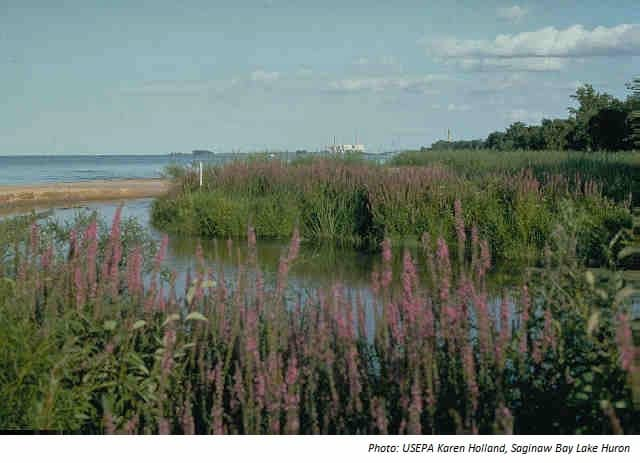
Increase the grants for AIS prevention and control
The last few years have brought significant reductions in the DNR grant monies made available to LGU’s and lake associations. This reduction was coincident with the $10 million in AIS Program Aid now flowing to the counties from the state legislature. As a result, many water bodies are no longer able to get DNR grant funds for AIS control efforts.
The need for more AIS control grants is exacerbated by the continued growth of AIS in lakes that have become infected with an AIS and need annual control treatments. The control costs are multiplying while the DNR continues to prioritize boater convenience over protection of the waters from AIS.
Communities including Mille Lacs have already undergone severe economic contraction with the crash of their fisheries brought on in significant part by the ravages of AIS. It is estimated that zebra mussels and spiny water fleas now filter every gallon of water in Mille Lacs every day.
Actions you can take:
- Talk to your legislators about the need to restore and increase the DNR AIS prevention and control grants given the continued growth in AIS infestations in Minnesota waters.
- Push your local county or watershed leaders to ensure that a large portion of their AIS Prevention Aid dollars is made available in the way of grants to lake and river associations.
Improve the distribution of the AIS Program Aid

One possible improvement is a change in the approach to distributing the AIS Program Aid funds across the state. From the State’s perspective, disbursing the funds by county is easy and convenient. But as many watersheds cross county borders, it makes protecting the key water bodies more complicated. Today’s county-based decision-making leads to inconsistent approaches to AIS prevention for the same watershed. A more thoughtful approach could allow distribution by watershed. That would be consistent with the new planning models that are done by watershed (One Watershed One Plan).
Action:
If your watershed crosses county borders, talk to your legislators about the distribution allocation model currently in place, versus moving to or including watershed districts where there is often greater expertise.

Increase annual state grant funding for AIS control
We advocate an increase in the amount of AIS Prevention Aid. The $10 million in annual funding motivated the citizenry to do more work to protect the lakes and rivers in Minnesota and yet there is so much more that could be done if there was more funding.
Action:
Talk to your legislators about the benefits of increasing the annual amount for AIS Program Aid. Action: Talk to your County Board members about the need for more funding for AIS prevention and push them to request it from their State Representatives and State Senators.
How Can We Prevent Problems?
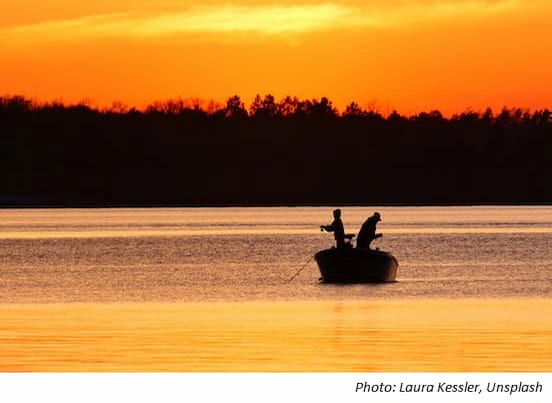

AIS fines at parity with hunting and fishing
Currently, there is a larger fine for taking a deer out of season than for bringing AIS to a lake. And yet the recreational value and the economic fallout to a lake are much, much greater.
Lake residents are at risk of having to pay to manage an AIS that was brought in by a single boater. It can be a downward pressure of realized value for property owners desiring to sell, and it can change county property taxes or levies for everyone in the county due to the loss of the higher-end tax base. For example, on Lake Koronis property assessors have determined a 3% reduction in property values due to AIS.
The DNR and other groups will try to convince you that the best answer is “education and awareness.” And to their credit, education has helped make most boaters aware of AIS, but it hasn’t always changed behavior. The recreational and economic consequences of bad behavior must not be allowed. It is not fair to anyone in the state, including the boater, who cannot possibly escape the detrimental economic and life-style changes that follow an infestation.
Having a financial deterrent in the form of hefty fines will complement the education to change behaviors, but these new fines must be put into law, and they must be enforced.
Businesses will falter or fail, services will be curtailed, and the ability to enjoy the thing that attracted them in the first place will be degraded. Each new AIS changes that lake forever. If we are serious about retaining the great fishing and pristine waters that remain, we must stop the spread of AIS.
Action:
Educate your legislators about the vital need to protect water bodies by enacting laws that have as much impact on changing behaviors as we have done for hunting and fishing. Work with your county, city and township units of government to get their licensed police officers trained on the AIS laws that they can enforce now. Fining (not just issuing warnings) for offenses of AIS laws will change behavior to protect your area lakes.
Improve boat inspection training
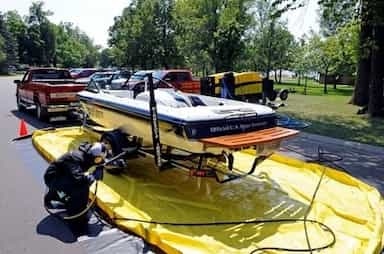
With increasing boater movement and thus the need for increasing the number of boat inspections, comes the need for a more robust rigorous inspection program. Approved inspectors are all certified by DNR whether they are hired directly by DNR or through an LGU delegation agreement. Inspector / inspection performance has been emphasized. It is important that these inspections receive not only consistent, uniform training from DNR but enhanced training in interpersonal skills and motivation. This enhanced training will reduce the risk of spread of AIS.
However, inspection and decontamination training is not uniform across the state and protocols need to be enhanced to further reduce the risk of spread of AIS.
Action:
Take action and communicate to your legislators and the DNR of the need for more aggressive inspection processes and better trained inspectors to stop the spread of AIS.
Ensure science expertise is included on advisory boards to guide policy

Too often, well-meaning advisory boards are not aware of scientific evidence or do not formulate AIS policy based on scientific evidence.
Too often AIS policy is set by well-meaning, but uninformed advisory boards where the result is policy that is not based on science.
In other cases, AIS policy is set so it will not aggravate some group(s) of users. While these policies may make people feel good (or not as offended), they will likely not make the situation improve, and may make the situation worse because the underlying problem is not addressed.
Action:
Talk to your legislators and local elected officials about the need to have experts on policy-setting boards so that science can be brought to bear as AIS problems and potential solutions are being decided.
How Can We Better Control AIS?
Faster and streamlined permitting for AIS control
The permitting process for AIS control efforts needs streamlining, especially for control efforts that are repeated year after year. For example, treatment to control Curlyleaf pondweed is typically a multi-year process but permitting for the treatment is a single-year process. A single year of treatment with no followup would in the long run be a waste of already limited resources. Planning and budgeting for a treatment regimen for this species needs a multi-year approach.
Action:
Talk to your legislators about the need to establish multi-year DNR AIS control permits.
Allow innovative solutions for AIS control
There is exciting, innovative work being driven at the local level, but some of these projects are denied approvals as they push the DNR beyond its comfort zone. If they are not precluded by State statute these kinds of projects must be allowed to move ahead as pilots in order to learn what works and what does not.
As an example, the regional AIS inspection program at Wright County was an example of a project that pushed the DNR beyond its comfort zone yet was fully supported by State statute. The program was delayed repeatedly and then after one full year of operation was finally turned down for expansion by the Commissioner of the DNR.
Action:
Ask your elected representatives to support legislative bills that remove unnecessary and delaying DNR “approvals” for work that is allowed by state statutes.
And we should be asking for legislative support to remove DNR Commissioner approval from regional inspection programs which meet all the requirements of the statute.
Close ramps when new AIS is detected and needs to be immediately addressed
There is no economic justification for keeping access open to a lake that becomes infested with a new AIS species that we do not know how to control (e.g., starry stonewort). Containment must be complete, including all DNR, LGU and private accesses before allowing access.
Action:
Talk to your legislators and local elected officials about the need to rethink the policies around public accesses in light of the recreational and economic costs of AIS.

Inspections and/or notifications of state AIS requirements at the state border
We can’t afford to have any more AIS coming into the state so there must be decontamination at the state borders. And we certainly don’t want to be an “exporter” of AIS to other states. This border protection model is already used with great success by several western states.
By establishing decontamination stations at existing MN DOT weigh stations, we can accomplish both of these important intents. As one example, we could stop hydrilla from entering Minnesota if we have this approach in place.
The western states know Lake Minnetonka by name as the lake that sends the most contaminated boats across their borders. This is a clear demonstration of our inability to manage AIS and for the transient boater’s unwillingness to take personal responsibility.
Action:
DNR and DOT are required by state statute to begin the dialog to see how this could be done. It is imperative that Minnesotans talk to their legislators about getting started on this concept. This is doable and must be pushed forward.

Provide Better Protection of Our Waters
Use natural filtration of vegetative cover and buffers
Often there are several ways to achieve the desired outcomes for protecting our waters and shorelines. As good stewards of the water, we should support any and all approaches that achieve or exceed the desired outcomes. Support efforts for natural filtration (vegetative cover, buffers, etc.) Over time, humans have altered the natural landscape from trees, shrubs and native grasses to a landscape that includes pavement, gravel, turf grass, and open soil. In doing so, we have increased the amount of sediment, nutrients and other pollutants that enter our lakes and streams every time it rains. These pollutants cloud our water and increase the growth of algae and aquatic plants to nuisance levels.
While these actions were generally well-intended, they resulted in an undesired result. Turf grasses typically have the shortest roots and thus the lowest ability to retain soils resulting in substantial runoff of sediment, nutrients, and other pollutants. Native plants have much longer root structures, so they hold the soil together better and increase infiltration. This results in not only a better yard but also improved water quality.
Action:
Contact your county Soil and Water Conservation District to publish recommendations to increase the native vegetation along shorelines. Consider creating a lake stewardship program so that lake residents can learn about the effects of their actions and what they can do to mitigate the harm.
Protect lakes and rivers from contaminants of animal waste and farm runoff
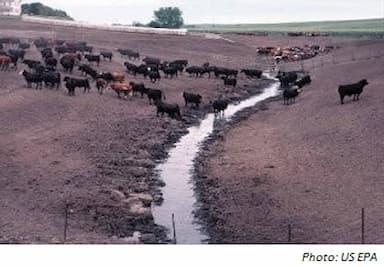
Rain and snow melt run off will carry the materials it passes over and through the landscape, including animal waste, fertilizers, herbicides, and pesticides. In addition, the runoff will contain bacteria and oxygen-demanding substances that will affect plants and animals. There are various practices that can be implemented to stop the unfiltered runoff from reaching water including contouring, grass borders and filter strips, and diversions.
Action:
Approach your County Board and ask them to formally support and approve variance mitigations that meet or exceed ordinance and rule-based protection of our waters and shorelines, and to not approve variances that fall short of that protection.
Protect lakes and rivers from contaminants of stormwater runoff
Unlike wastewater, stormwater is often untreated, and stormwater can be a significant source of pollution. Stormwater is created as rain falls on hard surfaces in an urban landscape, carrying fertilizers, pesticides, salts, oils, litter, and other materials that do not belong in the water. Managing the flow can reduce the contaminants and thus reduce the negative effects.
Action:
Learn more about your city or town’s stormwater management program. Is your city or town just barely meeting stormwater regulation requirements, or is there a way your community can do more?
Require compliant septic systems
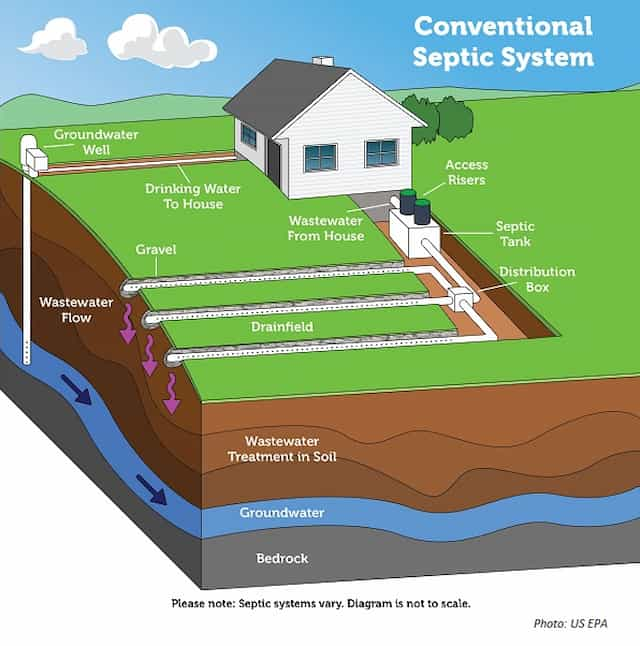
An unknown number of family cabins or older homes near our lakes and streams have faulty septic systems. Other systems may become faulty as the cabin or home’s use pattern changes from seasonal or weekend use to accommodating a full family or retired couple year-round. Faulty systems can leach harmful bacteria as well as nutrients and other pollutants into our waters. Often, the only way a faulty system is discovered is through an unsightly incident or through a required inspection that might occur with a point of sale or when a building permit is pulled.
Action:
Encourage your County Board and county staff to support measures that increase education about the harm of faulty septic systems, and to support programs that offer low or no interest loans for septic replacement. Encourage your County Board to increase the frequency of septic inspections. Further actions might include requirements for regular inspections on aging systems, required inspections on a regular basis for systems located near waterbodies, etc.
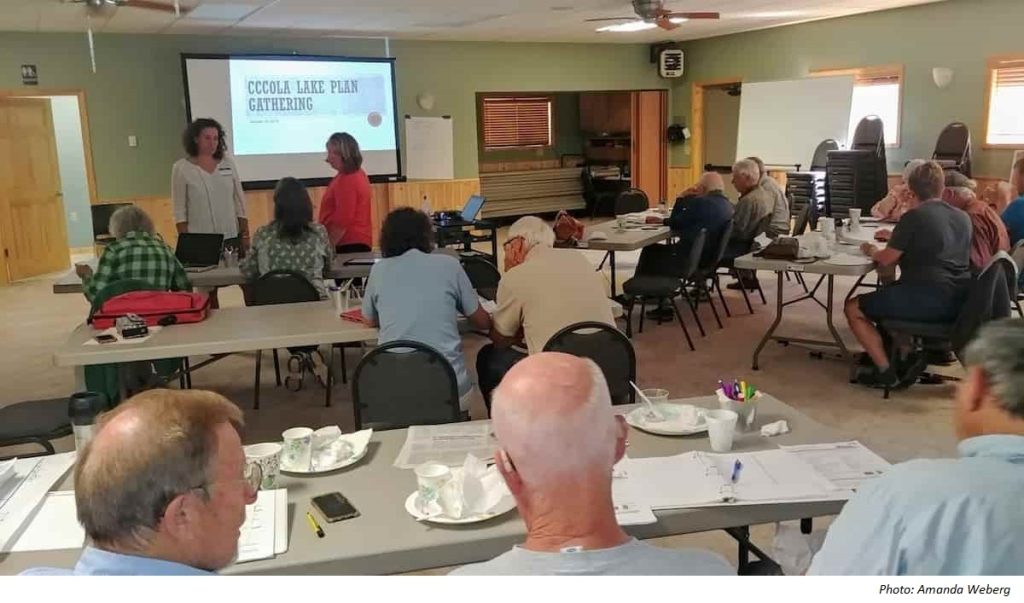
Incorporate Soil & Water Conservation District (SWCD) professional opinions in setting ordinances and allowing variances
Ordinances are created by state and local government in order to protect our resources, ensure reasonable privacy, and encourage safety in our communities. Upon a property owner’s request, a governing agency may examine a variance request to an ordinance and approve the request if it meets certain criteria. When variances are approved, stipulations can be established to reduce the impact of this variance. It is very difficult to restore water once it is impaired. So, in order to continue to protect our lakes and streams, it is important that water related ordinances are enforced, variances on ordinances are heavily scrutinized and minimally allowed, and best management practices are incorporated to the variance plans to reduce impact on nearby lakes and streams.
Action:
Approach your County Board and ask them to support shoreland ordinances that protect our waters, and to have expert Soil and Water Conservation District staff advise on proposed ordinances and variances.
Allow for alternative shoreland solutions that meet or exceed existing shoreline rules
Often there are several ways to achieve the desired outcomes for protecting our waters and shorelines. As good stewards of the water, we should support any and all approaches that achieve or exceed the desired outcomes.
Action:
Approach your County Board and ask them to formally support variances that meet or exceed ordinance and rule-based protection of our waters and shorelines.
Let’s be smart about the new risks to the water
Keep the Boundary Waters and St. Louis River basin free from potential release of sulfuric acid by rethinking the risk from copper/nickel mining proposals
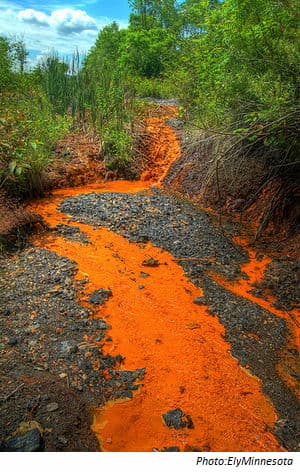
The mining industry does not have a good track record for copper/nickel mining around the globe, nor in the US. The disasters are significant when they occur. Processing the copper/nickel ore creates wastewater that cannot be discharged but must be contained and treated for hundreds of years. As Wikipedia notes: “The chemical processes involved in acid mine drainage are common around the world: where subsurface mining exposes metal sulfide minerals such as pyrite to water and air, this water must be carefully managed to prevent harm to riparian ecology.” (Wikipedia: “2015 Gold King Mine waste water spill“; “Background”)
A recent high-profile wastewater spill provides some insight as to the challenge of sulfide mining. An accidental wastewater release at the Gold King Mine near Silverton Colorado allowed three million gallons of mine wastewater and tailings, including heavy metals such as cadmium and lead, and other toxic elements, such as arsenic, beryllium, zinc, iron and copper into Colorado’s Animas River watershed which flows into the Colorado River.
The proposed Twin Metals copper/nickel mine north of the Laurentian Divide will flow into the Boundary Waters if they have a spill, while the PolyMet mine to the south of the Laurentian Divide will flow into the St. Louis River and ultimately Lake Superior.
The sound bites in favor of starting up these mines talk about the jobs to be created, the demand for these metals, and how the mining industry now has the best-practices to do it right in Minnesota. The sound bites against the mines talk about how few jobs will actually be created due to automation and the environmental risks to the downstream waters.
Action:
Talk to everyone you can at every level of government to let them know that you don’t think the currently planned approach to mining of these metals is environmentally sound and that the risks are not worth taking without a serious and significant change in the approach.
Protect our sensitive watersheds by rerouting new and replacement oil and tar sand pipelines toward lower risk routes
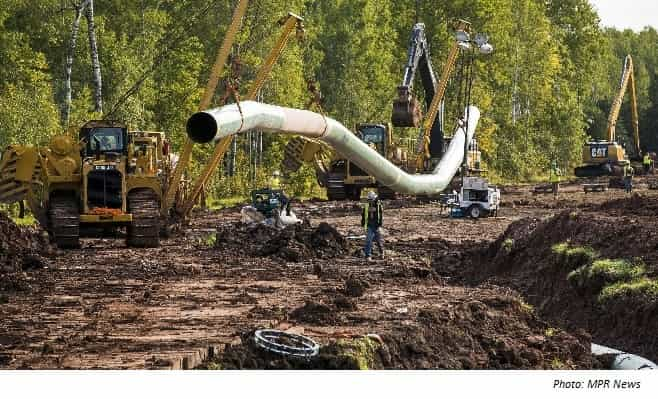
While there is a clear movement towards sustainable energy, the US still relies on petroleum to power most of our vehicles and to heat many of our homes and businesses. The pipes that carry crude oil from Alberta, Canada to Superior, Wisconsin are just a part of an old infrastructure that has reached the end of its life. Enbridge, a Canadian oil company, owns and operated these pipes and they want to replace them. This is known as the Line 3 pipeline project.
Our primary concern has to do with the route chosen for the new Line 3 pipeline and the fact that it goes right through one of Minnesota’s pristine water ecosystems, where pipeline spills are environmental disasters.
As MPR reported in June 2018: “the energy industry points out that they have safely transported 99.999% of oil. But that leaves the other .001 percent. And that’s the percentage that people in areas where pipes have leaked care about.”
As noted in Wikipedia: “… the original Line 3 pipeline was responsible for the largest ever inland oil spill in the U.S. In 1991, 1.7 million gallons of oil ruptured from Line 3 in Grand Rapids, MN. Enbridge was also responsible for the 2010 spill on the Kalamazoo River in Michigan.” (Wikipedia; “Line 3 pipeline“, “Oil Spills”) After eleven years and over a billion dollars spent, that spill is still being cleaned up.
Pipeline spills should be anticipated, and our intent is to have Enbridge re-route the pipeline to areas less environmentally sensitive to spills.
Several of Minnesota’s departments are involved including Natural Resources, Pollution Control, and Commerce.
Action:
Talk to everyone you can at every level of government in the state to let them know that you don’t think the environmental risks, both short and long term, are worth taking and that the proposed pipeline should be rerouted to a lower risk route.

Recreation on Minnesota Lakes
Establish regulations for watercraft that minimize shoreline and lakebed erosion, excessive turbulence, and disruption of fish spawning beds.
In 2017, an attorney in Michigan highlighted the challenges with wake boats and these are the exact issues we face in Minnesota. He noted that “as wake boarding has steadily increased in popularity over the past decade, statewide sales of recreational boats designed to create large, high energy wakes have also increased dramatically. Intense competition among wake boat manufacturers has led to the development of new technologies to improve the ability of their boats to create increasingly high energy wakes.”
He noted there at least three problems associated with such watercraft.
First, they are having significant negative environmental impacts on lakes from the downward thrust of prop wash as they tend to keep lake waters churned up (and murky) as well as continually disturbing the bottom lands of the shallower lakes, which imperils natural aquatic plants, insects, fish and microscopic life.
Second, wake boats are destroying natural shorelines as the waves created by wake boats are not only larger and more intense than waves created by conventional boats, but they also slam into shorelines with much greater force and velocity. Many riparian landowners have reported that shorelines which have for years been able to withstand conventional boating activity are being destroyed or disrupted in relatively short periods of time by the large waves from wake boats.
In addition, wake boats present significant safely hazards to other boaters, swimmers and even people resting or sitting on or in moored boats, swim rafts and docks. It is not uncommon for the wave from a wake boat to cause a person to fall down on or fall off of a dock or moored boat, or even break boat mooring lines.
Unfortunately, on relatively small and shallow water bodies, just a few wake boats operating irresponsibly (and even sometimes, operated in a normal fashion) can destroy many of the physical attributes that makes lake living attractive.
The damage to shorelines isn’t speculation. Peer-reviewed science confirms that boat wakes have been shown to have erosive effects on shorelines, scour the bottom of the shore face, and temporarily decrease water clarity. In addition to shoreline erosion, boat wake impacts include vegetative damage and disruption of fauna.
In the fall of 2020, the St. Anthony Falls Laboratory at the University of Minnesota began a research project to assess the wave energy and propeller thrust from various boat types operating under various real-world conditions. This science from the research will help to guide lake managers and legislators on best practices for boaters, including the distance a boat should be from shore and the minimum depth of the water for enhanced wake activities like wake boarding and wake surfing. The initial research report will likely come out in late 2021 or early 2022.
The Watersports Industry Association fears regulation of this fast-growing segment of the boating industry. They undertook their own research study and have been pushing various state legislatures around the country to implement laws that specify a minimum distance of 200 feet from shore for enhance wake activities. Unfortunately, their industry funded science has not been peer reviewed and questions have arisen as to the conclusions reached. In addition, the industry research and their proposed state regulations does not address the minimum depth of water that is appropriate for these enhanced wake activities. On a positive note, our Minnesota lawmakers are aware of the U of MN research that is in flight and have not allowed the industry-driven law to move forward.
Action:
According to the Minnesota DNR, “water surface use management” starts at the local unit of government -town, city or county, depending upon where the lake or river is located. Any ordinances proposed by the local unit of government must have a hearing and be approved by the DNR before they can go into effect. Get this topic on the agenda at your next lake association meeting to see if it is a common concern and assess if there is sufficient interest in pushing for a local solution, like a surface water restriction. Then push the issue with your local government officials and others:
- You might consider requesting a surface water restriction at a regional or county level.
- You can talk with your Minnesota Representative and Senator about getting consistent regulation on a state-wide level.
- You can talk with the local marine dealers who sell the wake/surf boats and equipment to push the best practices with their customers.
- At a minimum, you can work with your local and county governments for communication of the shoreline concern and the best practices for wake/surf boaters to reduce the impacts on shorelines.
Any individual shore owner can use riprap and other shoreline armoring strategies to combat erosion caused by boat wakes, but these practices also decrease natural habitat and water quality and can lead to erosion of adjoining unprotected properties. As such, armoring the shoreline is not recommended.
Do not stock muskies in non-muskie lakes
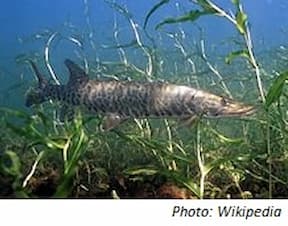
Muskies are native to about 44 Minnesota lakes and 8 major rivers. However, for many years, the DNR Muskie stocking program has artificially greatly expanded this natural distribution to another 60 plus lakes that did not have a native Muskie population.
The DNR and the Muskie anglers may want Minnesota to become the Muskie fishing capital of North America, but the scientific impacts to the ecology and the economic considerations are missing. The decisions for expansion in the numbers of Muskie lakes have been made without lake associations at the table, and lake association input collected during the public comment period has been routinely ignored.
There is insufficient science-based evidence to show that Muskie stocking in non-native lakes does not harm the biological balance of the lake.
Action:
Approach your legislators and local officials with the Muskie facts pertinent to your ecological concerns and long-term economic well-being of your area. Acknowledgement of the views from all sides of these issues are critical to finding a solution. And importantly, request that lake associations have a seat at the table when Muskie stocking recommendations are being considered.
Establish a watercraft operator license program
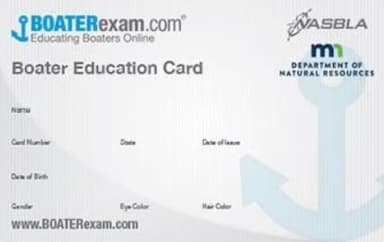
The Minnesota DNR presently has a Boater Education and Watercraft Operator’s Permit for youth, 12-17 years old. Completion of an online Boating Safety Course is required. Nevertheless, no education or permit is required if an adult is present. Youth under 12 years old can operate a boat under 25 HP and those 12-17 have no restrictions if with the adult. Personal Watercraft (Jet-skis) have only slightly more restrictions. Anyone over the age of 18 has no restrictions or educational requirements at all. Given the increasing size and power of modern boats, we think this lack of licensure is inadequate to assure safety and prevent environmental damage.
Action:
Discuss the benefits of requiring a boating license with your legislators and let’s get it put into effect as fast as possible.

Establish appropriate rules and regulations for lakes similar to MN state parks
Minnesota state parks are public and belong to all of us. Similarly, all open water in Minnesota is public water and belongs to all of us. Minnesota state parks have a plethora of rules and regulations including things like annual and/or daily use fees, hours of operation, hours of quiet time, parking rules, and no pets unless on a leash. Special fees are required to ride a horse, rock climb, cross country ski, and snowmobile. Funds from state park vehicle permits and fees are used to help manage park resources and facilities. It should be noted that many county parks also follow this same model.
Many lakes in Minnesota have similar public facilities including public water accesses, restrooms, parking lots, etc., and yet they individually struggle for funds to manage the resources. If you ask why, we can’t use a similar fee-based model to manage these resources, you often hear that there are restrictions put on by the federal government that limit what can be done.
As background, Minnesota has and continues to take advantage of federal funds to buy land and build public accesses. The US laws that established these funding mechanisms were established in simpler times when water was abundant, clean, and not at risk of AIS.
Let’s figure out ways to have usage fees to fund the protection and management of our precious water resources. It’s the people who are using the lakes who are causing the damage, so it’s only logical to have some portion of the cost the protect and manage the lakes paid for on a usage basis.
And let’s figure out ways to regulate usage, so that we don’t spoil what we have nor the opportunity for all to enjoy these incredible assets.
Actions you can take:
- Talk to your US Representatives and Senators to remove any real or perceived handcuffs from funding lake management with usage fees at DNR accesses as the simpler times are long gone.
- Talk to your county, township, and city officials about funding lake management with usage fees at non-DNR accesses as the simpler times are long gone. And let’s get the same kinds of logical regulations in place for all lakes as we do for state parks.
- Talk to your MN legislative members to evaluate the Federal oversite to our jointly funded lake accesses and/or instruct the MN DNR to revise their “open access despite the risks” attitude.


